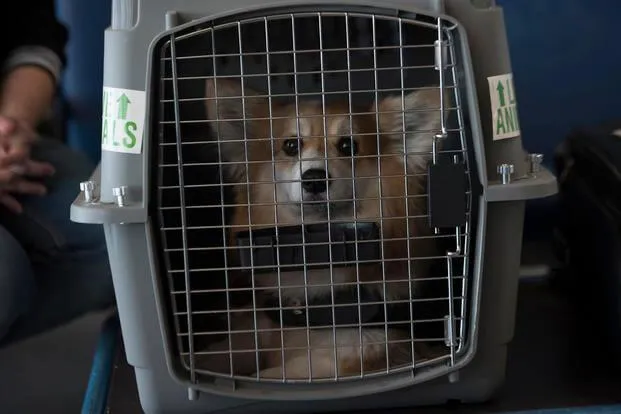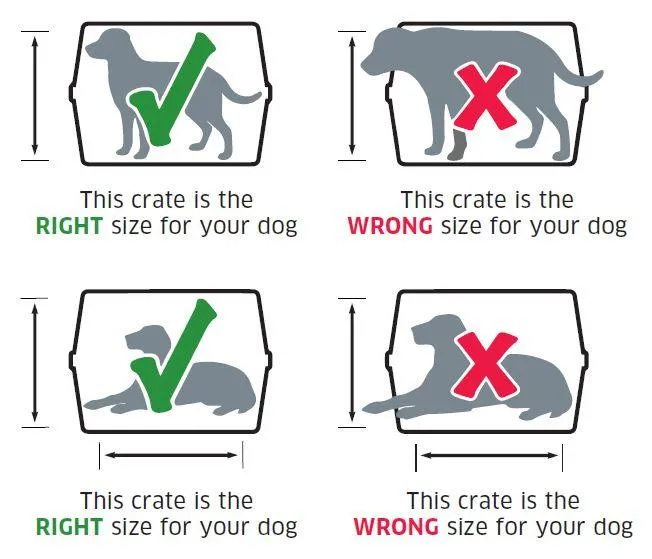Airline Dog Kennel Requirements: What You Need to Know for Flying with Your Furry Friend
Whether you’re jetting off on a dream vacation or making a long-distance move, transporting your dog by air brings up important questions about airline kennel requirements. As someone who has flown with dogs several times, here are the ins and outs of what’s required to keep Fido safe and legal in the cargo hold.
Kennel size
The first thing to check is that your dog’s carrier conforms to size limits set by the International Air Transport Association (IATA). For flights within the US, the kennel must be large enough for your dog to stand up, turn around, and lie down in a natural position. Most major carriers require the kennel to be no more than 24 inches by 18 inches by 9 inches for dogs under 20 lbs. Larger breeds need extra wiggle room in a 30x21x21 inch kennel or bigger. Make sure any handle, latches, or other features don’t cause the kennel to exceed maximum dimensions.
Kennel strength
Your dog’s kennel must be equipped with a locking mechanism to keep it securely shut during transport. The material should withstand rough baggage handling without breaking or allowing your dog to escape. Heavy-duty wire or plastic kennels with sturdy latches are typically okay, but soft-sided carriers or baskets won’t cut it. Wooden or fiberboard crates are best if they meet size specs. Inspect the crate thoroughly before flying to fix any damage or loose screws.
Ventilation
To prevent overheating, IATA requires at least 80% of a kennel’s surface to be mesh or openings that allow good airflow. Avoid solid-walled containers or those with small, high openings that your pup can’t get fresh air through. On hot flights, a collapsible water bowl and a few ice packs hidden under newspaper help keep your furball cool in the hold.

Identification
Clearly label your dog’s kennel with their name, your name, address, and contact information inside and out. Also affix an IATA-standard approved identification tag secured with string or zip ties to the crate. This tag contains travel details including the flight number and destination city. You’ll also need a health certificate from your vet and any required documentation for the destination country.
Food and water
Most airlines won’t allow food or water inside a kennel during transport for sanitation and spillage reasons. But pets must be fasting for 4-6 hours prior to check-in, as per IATA guidelines. As a caring pet parent, I always carry Fido’s bowls and a baggie of food in my carry-on so I can feed them right away upon arrival. Some pets get stressed flying, so play it safe by leaving water out too.
Pre-flight check-in
Arrive at the airport early knowing requirements vary between 1-3 hours before your departure time. Bring vet records, paperwork, and your pooch in their labeled kennel. Airlines may do a health check and refuse any animal deemed unfit to fly. On international itineraries, customs agents will also inspect dogs upon landing, so ensure travel documents are in order to avoid delays.
Transport paperwork
At check-in, you’ll be issued an Air Waybill receipt for transporting your kennel in the cargo hold. Treat this like a luggage tag as it proves the carrier’s responsibility for your pet. Copies may be requested upon collecting your pup at the destination. For peace of mind, I always email myself the flight details too, just in case paperwork gets misplaced during crazy travel days.

In-flight considerations
- Most importantly, choose direct flights if possible versus multi-leg itineraries that involve long layovers for your pooch.
- Non-stop trips subject dogs to shorter periods in cargo holds where extreme temperatures aren’t regulated.
- Opt for early morning or red-eye departures when holds are cooler versus baking all day in the heat.
- Ask for a check on your pup halfway through a long flight to ensure their comfort and that kennel remains securely stowed.
Picking up Fido
Upon arrival, be at baggage claim early as animals are unloaded before luggage. Bring ID used for check-in to verify ownership. Airlines may keep dogs waiting if no one claims them promptly. Expect a weary, perhaps stressed pup who’s just endured a big adventure! Once home, give plenty of love, water and rest before any long walks or playtime.
From my personal experiences flying with dogs, the key is thorough preparation by following all kennel size, identification and paperwork rules. Choosing direct flights whenever possible also improves animal welfare. While not ideal, modern carriers get millions of pets to their destinations safely each year when handled properly. With a little extra TLC, even the shyest of dogs can be comfortable flying companions.
In closing, I hope this overview of airline kennel requirements answered your questions about transporting a furry friend by air. Please let me know if any part of the process remains unclear. With diligent planning and caring for your pooch’s physical and emotional needs, you’ll both be tail-wagging at destinations near and far. Safe travels!
Airline Dog Kennel Requirements
| Airline | Size Limits | Weight Limit | Fees |
|---|---|---|---|
| Delta | Not larger than 20x10x10 inches | Under 70 lbs | $125 each way |
| American | Not larger than 19x13x9 inches | Under 100 lbs | $125 each way |
| United | Not larger than 18x11x7.5 inches | Under 100 lbs | $125 each way |
| Alaska | Not larger than 19x13x9 inches | Under 100 lbs | $75 each way |
| JetBlue | Not larger than 18x11x7 inches | Under 50 lbs | $100 each way |
FAQ
-
What size dog kennel do airlines allow?
Most airlines permit kennels that are roughly the size of a small dog carrier, around 21-27 inches long and 16-18 inches wide and tall. Bigger kennels than this are generally not approved, even for larger dog breeds. Some airlines place stricter size limits.

-
What paperwork is necessary?
You’ll need the dog’s vaccination records showing shots are up to date, as well as some airlines might insist on a health certificate from a vet. A travel kennel worth checking out is one that’s FAA approved, since that meets airline regulations. At the same time, be sure to review each airline’s rules regards to forms and docs.
-
Is there a weight limit for dogs on planes?
Many carriers will only take dogs under 20 pounds. However, certain airlines, basically Southwest, will allow larger puppers that weigh up to about 50 pounds maybe. But those bigger doggos may cost more, so always check policy details with your chosen airline first before booking Fido’s flight.
-
Are there any age restrictions?
Very young puppies under 3 months typically are not permitted in cargo due to vaccination requirements. Older dogs seem to be okay most times, yet certain breeds with shorter lifespans might get denied at like 10 years old. The vet can assist in appealing restrictions for healthier senior pups.
-
What if my dog is upset on the flight?
Most vets suggest calming aids like medication or calming treats when flying pets. Although results may vary and your dog still appears kind of anxious, at least the sedation helps reduce stress. It’s important your furry friend feels safe. But is sedation worth any risks? You’ll have to decide based on your pet.

-
How early should I check my dog in?
Airlines suggest arriving at least 2 hours before a domestic pet flight or 3 hours in advance for international journeys. However, who really wants to sit around that long with a nervous doggo? Perhaps give yourself an extra 30 minutes as a buffer in case of Paw-Traffic, and don’t forget calming snacks! Early is usually better to help Fido stay cool, calm and collected.
-
What if my dog gets lost by the airline?
You’d better hope that doesn’t occur! Each carrier has a process for locating lost pets, so record your contact info clearly on paperwork. Microchipping is also a good idea. Hopefully, airlines can reunite dogs and owners pretty stunningly. But if issues arise, be prepared to get vocal on social media with your frustrations!
